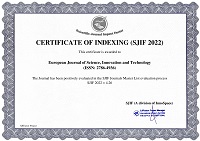Cell Signaling Pathway Proteins that Can Be Targeted to Keep in Check Proliferation in Cancer Cells: Scientific Review
Abstract
Cancer progression is primarily driven by uncontrolled cell proliferation, often resulting from dysregulated signaling and metabolic pathways. This review provides a comprehensive analysis of critical cell signaling pathway proteins that regulate cancer cell proliferation, highlighting potential therapeutic targets. It explores the role of proto-oncogenes, tumor suppressors, and key regulatory proteins such as p53, RB, cyclins, and CDKs in maintaining normal cell cycle progression and how their dysregulation promotes oncogenesis. The paper further delves into metabolic adaptations in cancer cells, including aerobic glycolysis and mitochondrial reprogramming, emphasizing enzymes like hexokinase, phosphofructokinase (PFK1), pyruvate kinase (PKM2), and lactate dehydrogenase (LDH) as central to the Warburg effect. Additionally, it discusses the significance of mitochondrial signaling in apoptosis, with a focus on the Bcl-2 family and the mitochondrial permeability transition pore (PTP) complex. The review integrates insights into protein import machinery (TOM and TIM complexes) and electron transport chain dynamics, underscoring their relevance to cancer cell survival and death. Emerging therapies such as targeted drugs, immunotherapies, and metabolic inhibitors are evaluated for their potential to selectively disrupt these pathways. The review advocates for a multi-targeted approach to cancer treatment that interferes with both proliferative signaling and metabolic support systems. This strategy may yield improved outcomes by halting tumor growth while preserving normal cellular function.
References
Blackadar CB. Historical review of the causes of cancer. World J Clin Oncol. 2016 Feb 10;7(1):54-86. doi: 10.5306/wjco.v7.i1.54. PMID: 26862491; PMCID: PMC4734938.
Cavenee, Webster K., and Raymond L. White. “The Genetic Basis of Cancer.” Scientific American, vol. 272, no. 3, 1995, pp. 72–79. JSTOR, http://www.jstor.org/stable/24980374. Accessed 16 Mar. 2025.
Junko Oshima and Judith Campisi. “Mammary Cell Proliferation and Morphogenesis” Fundamentals of Cell Proliferation: Control of the Cell Cycle 1995.
van den Heuvel S. Cell-cycle regulation. 2005 Sep 21. In: WormBook: The Online Review of C. elegans Biology [Internet]. Pasadena (CA): WormBook; 2005-2018. Available from: https://www.ncbi.nlm.nih.gov/books/NBK19719/
Israels, E. D., and L. G. Israels. "The cell cycle." The oncologist 5.6 (2000): 510-513.
Łukasik, P.; Załuski, M.; Gutowska, I. Cyclin-Dependent Kinases (CDK) and Their Role in Diseases Development–Review. Int. J. Mol. Sci. 2021, 22, 2935. https://doi.org/10.3390/ijms22062935.
Blagosklonny MV, Pardee AB. The Restriction Point of the Cell Cycle. In: Madame Curie Bioscience Database [Internet]. Austin (TX): Landes Bioscience; 2000-2013. Available from: https://www.ncbi.nlm.nih.gov/books/NBK6318/.
Robert A. Weinberg “The Retinoblastoma Protein and Cell Cycle Control” (1995). Whitehead Institute for Biomedical Research Massachusetts Institute of Technology Cambridge, Massachusetts 02142.
Engeland, K. Cell cycle regulation: p53-p21-RB signaling. Cell Death Differ 29, 946–960 (2022). https://doi.org/10.1038/s41418-022-00988-z
Bouska, Alyssa and Christine M. Eischen “Murine double minute 2: p53-independent roads lead to genome instability or death” Trends in Biochemical Sciences, Volume 34, Issue 6, 279 – 286 (2009). https://doi.org/10.1016/j.tibs.2009.02.006.
Roussel, M. The INK4 family of cell cycle inhibitors in cancer. Oncogene 18, 5311–5317 (1999). https://doi.org/10.1038/sj.onc.1202998
Finley, Lydia W.S. What is cancer metabolism. Cell, Volume 186, Issue 8, 1670 – 1688 (2023)
Bonora M, Patergnani S, Rimessi A, De Marchi E, Suski JM, Bononi A, Giorgi C, Marchi S, Missiroli S, Poletti F, Wieckowski MR, Pinton P. ATP synthesis and storage. Purinergic Signal. 2012 Sep;8(3):343-57.
Chandel, Navdeep S. "Glycolysis." Cold Spring Harbor Perspectives in Biology 13.5 (2021): a040535.
Xue-bing Li, Gu, Jun-Dong and Qing-hua Zhou. Review of aerobic glycolysis and its key enzymes – new targets for lung cancer therapy (2024). https://doi.org/10.1111/1759-7714.12148.
Lunt, Sophia Y., and Matthew G. Vander Heiden. “Aerobic Glycolysis: Meeting the Metabolic Requirements of Cell Proliferation.” Annual Review of Cell and Developmental Biology 27.1 (2011): 441–464
Wilson JE (2003) Isozymes of mammalian hexokinase: structure, subcellular localization and metabolic function. J Exp Biol 206: 2049–2057. doi:10.1242/jeb.00241
Katzen HM, Schimke RT (1965) Multiple forms of hexokinase in the rat: tissue distribution, age dependency, and properties. Proc Natl Acad Sci USA 54:1218–1225. doi:10.1073/pnas.54.4.1218
Polakis PG, Wilson JE (1985) An intact hydrophobic N-terminal sequence is critical for binding of rat brain hexokinase to mitochondria. Arch Biochem Biophys 236:328–337. doi:10.1016/ 0003-9861(85)90633-2.
Clarke, Donald Dudley PhD and Sokoloff, Louis, "Circulation and energy metabolism in the brain / Donald D. Clarke and Louis Sokoloff" (1999). Chemistry Faculty Publications. 81. https://fordham.bepress.com/chem_facultypubs/81
Sebastian, Siby, Jay D. Horton, and John E. Wilson. "Anabolic function of the type II isozyme of hexokinase in hepatic lipid synthesis." Biochemical and biophysical research communications 270.3 (2000): 886-891.
Kaselonis, G. L., E. R. B. McCabe, and S. M. Gray. "Expression of Hexokinase 1 and Hexokinase 2 in Mammary Tissue of Nonlactating and Lactating Rats: Evaluation by RT–PCR." Molecular genetics and metabolism 68.3 (1999): 371-374.
Goldhammer, Alan R., and Hasko H. Paradies. "Phosphofructokinase: structure and function." Current topics in cellular regulation 15 (1979): 109-141.
Wang, Chengcheng, Mackenzie J. Taylor, Chandler D. Stafford, David S. Dang, Sulaiman K. Matarneh, David E. Gerrard, and Jinglu Tan. "Analysis of phosphofructokinase-1 activity as affected by pH
Hers HG, VanSchaftingen E.1982.Fructose2,6-bisphosphate 2 years after its discovery. Biochem J 206: 1–12
Mor, I., E. C. Cheung, and K. H. Vousden. "Control of glycolysis through regulation of PFK1: old friends and recent additions." In Cold Spring Harbor symposia on quantitative biology, vol. 76, pp. 211-216. Cold Spring Harbor Laboratory Press, 2011.
Ismail, Rehana, and Mahboob Ul Hussain. "The up regulation of phosphofructokinase1 (PFK1) protein during chemically induced hypoxia is mediated by the hypoxia-responsive internal ribosome entry site (IRES) element, present in its 5′ untranslated region." Biochimie 139 (2017): 38-45.
Webb, B., Forouhar, F., Szu, FE. et al. Structures of human phosphofructokinase-1 and atomic basis of cancer-associated mutations. Nature 523, 111–114 (2015). https://doi.org/10.1038/nature14405
García M, Pujol A, Ruzo A, Riu E, Ruberte J, Arbós A, et al. (2009) Phosphofructo-1-Kinase Deficiency Leads to a Severe Cardiac and Hematological Disorder in Addition to Skeletal Muscle Glycogenosis. PLoS Genet 5(8): e1000615. https://doi.org/10.1371/journal.pgen.1000615
Yalcin A, Telang S, Clem B, Chesney J. 2009b. Regulation of glucose metabolism by 6-phosphofructo-2-kinase/fructose 2,6-bisphosphatases in cancer. Exp Mol Pathol 86: 174–179
Sakai, Akiko, Aki Kusumoto, Yoshinobu Kiso, and Eisuke Furuya. "Itaconate reduces visceral fat by inhibiting fructose 2, 6-bisphosphate synthesis in rat liver." Nutrition 20, no. 11-12 (2004): 997-1002.
Wu, Chaodong, Salmaan A. Khan, Li-Jen Peng, and Alex J. Lange. "Roles for fructose-2, 6-bisphosphate in the control of fuel metabolism: beyond its allosteric effects on glycolytic and gluconeogenic enzymes." Advances in enzyme regulation 46, no. 1 (2006): 72-88.
Güzel, Saime; Yalçin, Abdullah; Gürpinar, Yunus; and Güler, Sabire (2023) "Expression of Pfkfb isoenzymes during in vitro differentiation of mouse embryonic stem cells into insulin-producing cells," Turkish Journal of Medical Sciences: Vol. 53: No. 6, Article 5. https://doi.org/10.55730/1300-0144.5725 Available at: https://journals.tubitak.gov.tr/medical/vol53/iss6/5
Minchenko, Oleksandr, Iryna Opentanova, and Jaime Caro. "Hypoxic regulation of the 6-phosphofructo-2-kinase/fructose-2, 6-bisphosphatase gene family (PFKFB-1–4) expression in vivo." FEBS letters 554, no. 3 (2003): 264-270.
Yalcin, Abdullah, Sucheta Telang, Brian Clem, and Jason Chesney. "Regulation of glucose metabolism by 6-phosphofructo-2-kinase/fructose-2, 6-bisphosphatases in cancer." Experimental and molecular pathology 86, no. 3 (2009): 174-179.
Rider MH, Bertrand L, Vertommen D, Michels PA, Rousseau GG, Hue L. 2004. 6-Phosphofructo-2-kinase/fructose-2,6 bisphosphatase: Head-to-head with a bifunctional enzyme that controls glycolysis. Biochem J 381: 561–579
Atsumi T, Nishio T, Niwa H, Takeuchi J, Bando H, Shimizu C, Yoshioka N, Bucala R, Koike T. 2005. Expression of induci ble 6-phosphofructo-2-kinase/fructose-2,6-bisphosphatase/PFKFB3 isoforms in adipocytes and their potential role in glycolytic regulation. Diabetes 54: 3349–3357
Moon JS, Jin WJ, Kwak JH, Kim HJ, Yun MJ, Kim JW, Park SW, Kim KS. 2010. Androgen stimulates glycolysis for de novo lipid synthesis by increasing the activities of hexokinase 2 and 6-phosphofructo-2-kinase/fructose-2,6-bisphosphatase 2 in prostate cancer cells. Biochem J 433: 225–233.
Almeida A, Bolanos JP, Moncada S. 2010. E3 ubiquitin ligase APC/C-Cdh1 accounts for the Warburg effect by linking glycolysis to cell proliferation. Proc Natl Acad Sci 107: 738–741.
Altenberg, B. and Greulich, K. O. (2004). Genes of glycolysis are ubiquitously overexpressed in 24 cancer classes. Genomics 84, 1014-1020.
Yamada K, Noguchi T. Regulation of pyruvate kinase M gene expression. Biochem Biophys Res Commun 1999;256: 257–62.
Zanella, Alberto, Elisa Fermo, Paola Bianchi, Laurent Roberto Chiarelli, and Giovanna Valentini. "Pyruvate kinase deficiency: the genotype-phenotype association." Blood reviews 21, no. 4 (2007): 217-231.
Christofk, Heather R., Matthew G. Vander Heiden, Marian H. Harris, Arvind Ramanathan, Robert E. Gerszten, Ru Wei, Mark D. Fleming, Stuart L. Schreiber, and Lewis C. Cantley. "The M2 splice isoform of pyruvate kinase is important for cancer metabolism and tumour growth." Nature 452, no. 7184 (2008): 230-233.
Noguchi, Tamio, Hiroyasu Inoue, and Takehiko Tanaka. "The M1-and M2-type isozymes of rat pyruvate kinase are produced from the same gene by alternative RNA splicing." Journal of Biological Chemistry 261, no. 29 (1986): 13807-13812.
Kazuya YAMADA, Tamio NOGUCHI; Nutrient and hormonal regulation of pyruvate kinase gene expression. Biochem J 1 January 1999; 337 (1): 1–11. doi: https://doi.org/10.1042/bj3370001
Bluemlein, K., Gru¨ning, N. M., Feichtinger, R. G., Lehrach, H., Kofler, B. and Ralser, M. (2011). No evidence for a shift in pyruvate kinase PKM1 to PKM2 expression during tumorigenesis. Oncotarget 2, 393-400
Yang, Weiwei, and Zhimin Lu. "Pyruvate kinase M2 at a glance." Journal of cell science 128, no. 9 (2015): 1655-1660.
Yang, W., Xia, Y., Ji, H., Zheng, Y., Liang, J., Huang, W., Gao, X., Aldape, K. and Lu, Z. (2011). Nuclear PKM2 regulates beta-catenin transactivation upon EGFR activation. Nature 480, 118-122.
Yang, W., Xia, Y., Hawke, D., Li, X., Liang, J., Xing, D., Aldape, K., Hunter, T., Alfred Yung, W. K. and Lu, Z. (2012). PKM2 phosphorylates histone H3 and promotes gene transcription and tumorigenesis. Cell 150, 685 696.
Dombrauckas, J. D., Santarsiero, B. D. and Mesecar, A. D. (2005). Structural basis for tumor pyruvate kinase M2 allosteric regulation and catalysis. Biochemistry 44, 9417-9429.
Chaneton, B., Hillmann, P., Zheng, L., Martin, A. C., Maddocks, O. D., Chokkathukalam, A., Coyle, J. E., Jankevics, A., Holding, F. P., Vousden, K. H. et al. (2012). Serine is a natural ligand and allosteric activator of pyruvate kinase M2. Nature 491, 458-462.
Keller, K. E., Tan, I. S. and Lee, Y. S. (2012). SAICAR stimulates pyruvate kinase isoform M2 and promotes cancer cell survival in glucose-limited conditions. Science 338, 1069-1072.
Hitosugi, T., Kang, S., Vander Heiden, M. G., Chung, T. W., Elf, S., Lythgoe, K., Dong, S., Lonial, S., Wang, X., Chen, G. Z. et al. (2009). Tyrosine phosphorylation inhibits PKM2 to promote the Warburg effect and tumor growth. Sci. Signal. 2, ra73.
Lu, Z. (2012). PKM2 functions as a histone kinase. Cell Cycle 11, 4101-4102.
Gao, X., Wang, H., Yang, J. J., Liu, X. and Liu, Z. R. (2012). Pyruvate kinase M2 regulates gene transcription by acting as a protein kinase. Mol. Cell 45, 598 609.
Luo, W., Hu, H., Chang, R., Zhong, J., Knabel, M., O’Meally, R., Cole, R. N., Pandey, A. and Semenza, G. L. (2011). Pyruvate kinase M2 is a PHD3 stimulated coactivator for hypoxia-inducible factor 1. Cell 145, 732-744.
Schumann G, Bonora R, Ceriotti F, Clerc-Renaud P, Ferrero CA, Férard G, Franck PF, Gella FJ, Hoelzel W, Jørgensen PJ, Kanno T, Kessner A, Klauke R, Kristiansen N, Lessinger JM, Linsinger TP, Misaki H, Panteghini M, Pauwels J, Schimmel HG, Vialle A, Weidemann G, Siekmann L. IFCC primary reference procedures for the measurement of catalytic activity concentrations of enzymes at 37 degrees C. Part 3. Reference procedure for the measurement of catalytic concentration of lactate dehydrogenase. Clin Chem Lab Med. 2002 Jun;40(6):643-8. [PubMed]
Passarella S, Schurr A. l-Lactate Transport and Metabolism in Mitochondria of Hep G2 Cells-The Cori Cycle Revisited. Front Oncol. 2018;8:120. [PubMed]
Adeva-Andany M, López-Ojén M, Funcasta-Calderón R, Ameneiros-Rodríguez E, Donapetry-García C, Vila-Altesor M, Rodríguez-Seijas J. Comprehensive review on lactate metabolism in human health. Mitochondrion. 2014 Jul;17:76-100. [PubMed]
Liberti MV, Locasale JW. The Warburg Effect: How Does it Benefit Cancer Cells? Trends Biochem Sci. 2016 Mar;41(3):211-218. [PubMed]
Drent M, Cobben NA, Henderson RF, Wouters EF, van Dieijen-Visser M. Usefulness of lactate dehydrogenase and its isoenzymes as indicators of lung damage or inflammation. Eur Respir J. 1996 Aug;9(8):1736-42. [PubMed]
Liang X, Liu L, Fu T, Zhou Q, Zhou D, Xiao L, Liu J, Kong Y, Xie H, Yi F, Lai L, Vega RB, Kelly DP, Smith SR, Gan Z. Exercise Inducible Lactate Dehydrogenase B Regulates Mitochondrial Function in Skeletal Muscle. J Biol Chem. 2016 Dec 02;291(49):25306-25318.[PubMed].
de Bari L, Atlante A. Including the mitochondrial metabolism of L-lactate in cancer metabolic reprogramming. Cell Mol Life Sci. 2018 Aug;75(15):2763-2776. [PubMed]
Chinnery, Patrick F., and Eric A. Schon. "Mitochondria." Journal of Neurology, Neurosurgery &
Faou, Pierre, and Nicholas J. Hoogenraad. "Tom34: a cytosolic cochaperone of the Hsp90/Hsp70 protein complex involved in mitochondrial protein import." Biochimica et Biophysica Acta (BBA)-Molecular Cell Research 1823, no. 2 (2012): 348-357.
Anderson S, Bankier AT, Barrell BG, et al. Sequence and organization of the human mitochondrial genome. Nature 1981;290:457–65.
van Gurp M, Festjens N, van Loo G, Saelens X, Vandenabeele P: Mitochondrial intermembrane proteins in cell death. Biochem Biophys Res Commun 304: 487–497. 2003.
Kroemer G: Mitochondrial control of apoptosis: An introduction. Biochem Biophys Res Commun 304: 433–435, 2003
Lemasters JJ, Nieminen AL, Qian T, Trost LC, Elmore SP, Nishimura Y, Crowe RA, Cascio WE, Bradham CA, Brenner DA, Herman B: The mitochondrial permeability transition in cell death: A common mechanism in necrosis, apoptosis and autophagy. Biochim Biophys Acta 1366: 177–196, 1998
Marzo I, Brenner C, Zamzami N, Jurgensmeier JM, Susin SA, Vieira HL, Prevost MC, Xie Z, Matsuyama S, Reed JC, Kroemer G: Bax and adenine nucleotide translocator cooperate in the mitochondrial control of apoptosis. Science 281: 2027–2031, 1998
Li H, Kolluri SK, Gu J, Dawson MI, Cao X, Hobbs PD, Lin B, Chen G, Lu J, Lin F, Xie Z, Fontana JA, Reed JC, Zhang X: Cytochrome c release and apoptosis induced by mitochondrial targeting of nuclear orphan receptor TR3. Science 289: 1159–1164, 2000
Rapaport, Doron. "How does the TOM complex mediate the insertion of precursor proteins into the mitochondrial outer membrane?" Journal of Cell Biology 171, no. 3 (2005): 419-423.
Bykov, Y. S., Rapaport, D., Herrmann, J. M., and Schuldiner, M. (2020) Cytosolic events in the biogenesis of mitochondrial proteins. Trends Biochem. Sci. 45, 650–667 14.
Young, J. C., Barral, J. M., and Ulrich Hartl, F. (2003) More than folding: Localized functions of cytosolic chaperones. Trends Biochem. Sci. 28, 541–547 16.
Meisinger, Chris, Michael T. Ryan, Kerstin Hill, Kirstin Model, Joo Hyun Lim, Albert Sickmann, Hanne Müller, Helmut E. Meyer, Richard Wagner, and Nikolaus Pfanner. "Protein import channel of the outer mitochondrial membrane: a highly stable Tom40-Tom22 core structure differentially interacts with preproteins, small tom proteins, and import receptors." Molecular and cellular biology 21, no. 7 (2001): 2337-2348.
Sayyed, Ulfat Mohd Hanif, and Radhakrishnan Mahalakshmi. "Mitochondrial protein translocation machinery: From TOM structural biogenesis to functional regulation." Journal of Biological Chemistry 298, no. 5 (2022): 101870
Bausewein, T., Mills, D. J., Langer, J. D., Nitschke, B., Nussberger, S., and Kuhlbrandt, W. (2017) Cryo-EM structure of the TOM core complex from Neurospora crassa. Cell 170, 693–700.e7
Wang, W., Chen, X., Zhang, L., Yi, J., Ma, Q., Yin, J., Zhuo, W., Gu, J., and Yang, M. (2020) Atomic structure of human TOM core complex. Cell Discov. 6,67 29.
Yano, M., Hoogenraad, N., Terada, K., and Mori, M. (2000) Identification and functional analysis of human Tom22 for protein import into mitochondria. Mol. Cell. Biol. 20, 7205–7213.
Perry, A. J., Hulett, J. M., Likic, V. A., Lithgow, T., and Gooley, P. R. (2006) Convergent evolution of receptors for protein import into mitochondria. Curr. Biol. 16, 221–229
Fan, A. C., Kozlov, G., Hoegl, A., Marcellus, R. C., Wong, M. J., Gehring, K., and Young, J. C. (2011) Interaction between the human mitochon drial import receptors Tom20 and Tom70 in vitro suggests a chaperone displacement mechanism. J. Biol. Chem. 286, 32208–32219.
Saitoh, T., Igura, M., Obita, T., Ose, T., Kojima, R., Maenaka, K., Endo, T., and Kohda, D. (2007) Tom20 recognizes mitochondrial presequences through dynamic equilibrium among multiple bound states. EMBO J. 26, 4777–4787.
Sollner, G. Griffiths, R. Pfaller, N. Pfanner, W. Neupert, MOM19, an import receptor for mitochondrial precursor proteins, Cell 59 (1989) 1061–1070
Fan, G. Kozlov, A. Hoegl, R.C. Marcellus, M.J. Wong, K. Gehring, J.C. Young, Interaction between the human mitochondrial import receptors Tom20 and Tom70 in vitro suggests a chaperone displacement mechanism, J. Biol. Chem. 286 (2011) 32208–32219.
Neupert, Protein import into mitochondria, Annu. Rev. Biochem. 66 (1997) 863–917.
Young, N.J. Hoogenraad, F.U. Hartl, Molecular chaperones Hsp90 and Hsp70 deliver preproteins to the mitochondrial import receptor Tom70, Cell 112 (2003) 41–50.
Pearl, C. Prodromou, Structure and mechanism of the Hsp90 molecular chaperone machinery, Annu. Rev. Biochem. 75 (2006) 271–294.
Scheufler, A. Brinker, G. Bourenkov, S. Pegoraro, L. Moroder, H. Bartunik, F.U. Hartl, I. Moarefi, Structure of TPR domain-peptide complexes: critical elements in the assembly of the Hsp70–Hsp90 multichaperone machine, Cell 101 (2000) 199–210.
Young, I. Moarefi, F.U. Hartl, Hsp90: a specialized but essential protein-folding tool, J. Cell Biol. 154 (2001) 267–273.
Agarraberes, J.F. Dice, A molecular chaperone complex at the lysosomal mem brane is required for protein translocation, J. Cell Sci. 114 (2001) 2491–2499
Faou, Pierre, and Nicholas J. Hoogenraad. "Tom34: a cytosolic cochaperone of the Hsp90/Hsp70 protein complex involved in mitochondrial protein import." Biochimica et Biophysica Acta (BBA)-Molecular Cell Research 1823, no. 2 (2012): 348-357.
Jensen, Robert E., and Cory D. Dunn. "Protein import into and across the mitochondrial inner membrane: role of the TIM23 and TIM22 translocons." Biochimica et Biophysica Acta (BBA)-Molecular Cell Research 1592, no. 1 (2002): 25-34.
Rehling, N. Wiedemann, N. Pfanner, K.N. Truscott, Crit. Rev. Biochem. Mol. Biol. 36 (2001) 291–336.
Roise, David, and Gottfried Schatz. "Mitochondrial presequences." Journal of Biological Chemistry 263, no. 10 (1988): 4509-4511.
von Heijne, Gunnar. "Mitochondrial targeting sequences may form amphiphilic helices." The EMBO journal 5, no. 6 (1986): 1335.
Curran, Sean P., Danielle Leuenberger, Einhard Schmidt, and Carla M. Koehler. "The role of the Tim8p–Tim13p complex in a conserved import pathway for mitochondrial polytopic inner membrane proteins." The Journal of cell biology 158, no. 6 (2002): 1017-1027.
Truscott, K.N., P. Kovermann, A. Geissler, A. Merlin, M. Meijer, A.J. Driessen, J. Rassow, N. Pfanner, R. Wagner, Nat. Struct. Biol. 8 (2001) 1074–1082.
Bauer, M.F., C. Sirrenberg, W. Neupert, M. Brunner, Cell 87 (1996) 33–41.
Jensen, R.E., Johnson, A.E. Curr. Biol. 9 (1999) R779–R782
Gakh, Oleksandr, Patrizia Cavadini, and Grazia Isaya. “Mitochondrial processing peptidases.” Biochimica et Biophysica Acta (BBA)-Molecular cell Research 1592, no. 1 (2002): 63-77.
Bohnert, Maria, Peter Rehling, Bernard Guiard, Johannes M. Herrmann, Nikolaus Pfanner, and Martin Van Der Laan. "Cooperation of stop-transfer and conservative sorting mechanisms in mitochondrial protein transport." Current biology 20, no. 13 (2010): 1227-1232.
Glick, Benjamin S., Anders Brandt, Kyle Cunningham, Sabina Müller, Richard L. Hallberg, and Gottfried Schatz. "Cytochromes c1 and b2 are sorted to the intermembrane space of yeast mitochondria by a stop-transfer mechanism." Cell 69, no. 5 (1992): 809-822.
Rojo, Elena E., Bernard Guiard, Walter Neupert, and Rosemary A. Stuart. "N-terminal Tail Export from the Mitochondrial Matrix: ADHERENCE TO THE PROKARYOTIC “POSITIVE-INSIDE” RULE OF MEMBRANE PROTEIN TOPOLOGY." Journal of Biological Chemistry 274, no. 28 (1999): 19617-19622.
Geissler, Andreas, Thomas Krimmer, Ulf Bomer, Bernard Guiard, Joachim Rassow, and Nikolaus Pfanner. "Membrane potential-driven protein import into mitochondria: the sorting sequence of cytochrome b 2Modulates the Δψ-dependence of translocation of the matrix-targeting sequence." Molecular biology of the cell 11, no. 11 (2000): 3977-3991.
Kovermann, Peter, Kaye N. Truscott, Bernard Guiard, Peter Rehling, Naresh B. Sepuri, Hanne Müller, Robert E. Jensen, Richard Wagner, and Nikolaus Pfanner. "Tim22, the essential core of the mitochondrial protein insertion complex, forms a voltage-activated and signal-gated channel." Molecular cell 9, no. 2 (2002): 363-373.
Koehler, Carla M., Michael P. Murphy, Nikolaus A. Bally, Danielle Leuenberger, Wolfgang Oppliger, Luisita Dolfini, Tina Junne, Gottfried Schatz, and Eran Or. "Tim18p, a new subunit of the TIM22 complex that mediates insertion of imported proteins into the yeast mitochondrial inner membrane." Molecular and cellular biology 20, no. 4 (2000): 1187-1193.
Hobbs, Alyson E. Aiken, Maithreyan Srinivasan, J. Michael McCaffery, and Robert E. Jensen. "Mmm1p, a mitochondrial outer membrane protein, is connected to mitochondrial DNA (mtDNA) nucleoids and required for mtDNA stability." The Journal of cell biology 152, no. 2 (2001): 401-410.
Adam, A., M. Endres, C. Sirrenberg, F. Lottspeich, W. Neupert, M. Brunner, EMBO J. 18 (1999) 313–319.
Yin, Maureen, and Luke AJ O’Neill. "The role of the electron transport chain in immunity." The FASEB journal 35, no. 12 (2021): e21974.
Lenaz G, Fato R, Genova ML, Bergamini C, Bianchi C, Biondi A. Mitochondrial complex I: structural and functional as pects. Biochim Biophys Acta. 2006;1757(9-10):1406-1420. doi:10.1016/j.bbabio.2006.05.007
Al-Khallaf, Hamoud. "Isocitrate dehydrogenases in physiology and cancer: biochemical and molecular insight." Cell & bioscience 7 (2017): 1-18.
Scialo F, Fernandez- Ayala DJ, Sanz A. Role of mitochondrial reverse electron transport in ROS signaling: potential roles in health and disease. Front Physiol. 2017;8:428. doi:10.3389/ fphys.2017.00428.
Hu L, Wang Z, Carmone C, Keijer J, Zhang D. Role of oxidative DNA damage and repair in atrial fibrillation and ischemic heart disease. Int J Mol Sci. 2021;22(8):3838. doi:10.3390/ijms2 2083838
Cobley JN. Mechanisms of mitochondrial ROS production in assisted reproduction: the known, the unknown, and the intriguing. Antioxidants. 2020;9(10):933. doi:10.3390/antio x910093
Debela DT, Muzazu SG, Heraro KD, et al. New approaches and procedures for cancer treatment: Current perspectives. SAGE Open Medicine. 2021;9. doi:10.1177/20503121211034366
Doll R, Peto R: The causes of cancer: Quantitative estimates of avoidable risks of cancer in the United States today. J Natl Cancer Inst 66::1191,1981-1308.
Copyright (c) 2025 Otieno Rolex Opiyo, Omollo Reagan Sylvester, Godfrey Mutuma Gitonga, Dorothy Kagendo Kithinji, Daniel Muthee Gaichu, Oribo Calleb Magutu, Stephen Kipkosgei Kurui

This work is licensed under a Creative Commons Attribution 4.0 International License.


 ISSN
ISSN 











